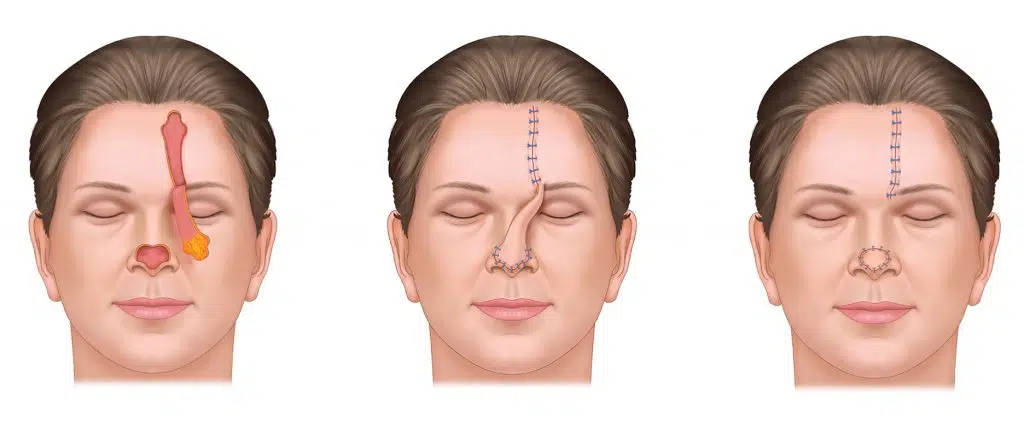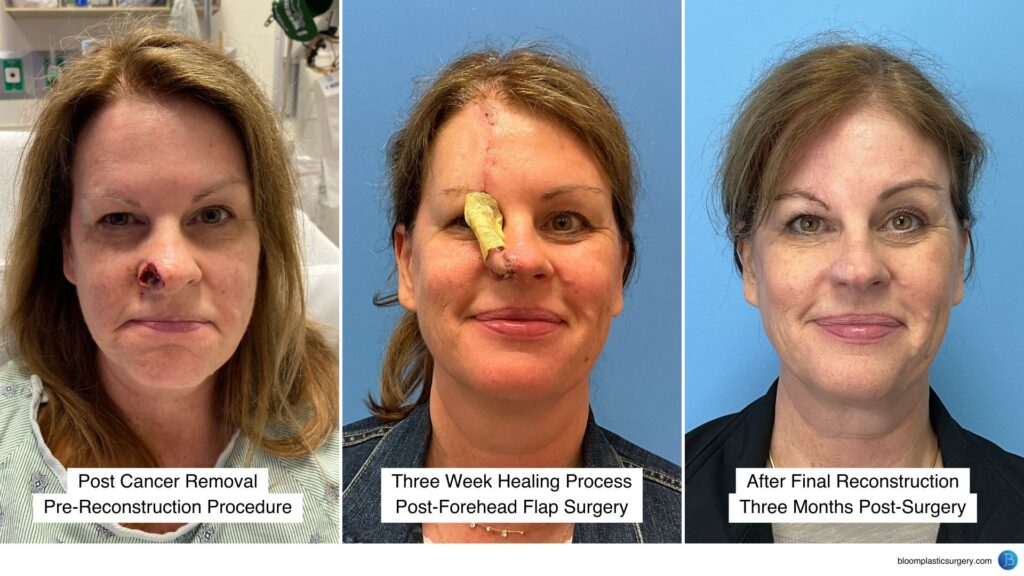CASE STUDY
Reconstructive plastic surgery plays a vital role in restoring both function and appearance after skin cancer removal, particularly in areas as delicate as the nose. Dr. Jacob Bloom specializes in advanced reconstructive plastic surgery techniques that follow procedures like Mohs surgery. While Dr. Bloom does not perform Mohs surgery, he is an expert in the next critical step. This step is restoring the patient’s natural features after the cancerous tissue is removed. One of the most effective techniques used in nasal reconstruction is the Paramedian Forehead Flap. In cases of nasal reconstruction, this is often accompanied by a cartilage graft from the ear.
What Is a Paramedian Forehead Flap?
A paramedian forehead flap is a reconstructive technique that uses healthy, vascularized skin from the forehead to rebuild the nasal area. This procedure is particularly beneficial for cases where significant tissue loss occurs, such as after the removal of skin cancer. This is because the forehead tissue closely matches the texture and color of nasal skin.
The process begins with harvesting a section of skin from the forehead. The blood supply to this tissue is preserved, ensuring that the transplanted tissue can survive and integrate with the surrounding nasal area. In some cases, particularly when structural support is needed, a cartilage graft from the ear is used in combination with the forehead flap. This ensures a more stable and long-lasting reconstruction, helping to maintain the shape and function of the nose.

How the Reconstruction Procedure Works
Here’s a step-by-step breakdown of how Dr. Bloom performs nasal reconstruction using a paramedian forehead flap:
- Initial Surgery and Forehead Flap Creation: Once Mohs surgery is complete, Dr. Bloom assesses the extent of the tissue loss. In cases where the nasal alar (the outside curve of the nostril) is involved, a large amount of tissue may need to be reconstructed. The paramedian forehead flap is then created by taking healthy skin from the forehead, leaving its blood supply intact.
- Cartilage Graft (If Required): If structural support is needed, a small amount of cartilage is harvested from the patient’s ear. This cartilage is then placed in the nasal area to provide the necessary support and shape, ensuring the best long-term aesthetic and functional outcomes.
- Attaching the Forehead Flap: The forehead skin is carefully positioned over the nasal defect, ensuring that the vascular connections remain strong. This step allows the new tissue to integrate with the surrounding nasal skin, forming the foundation for a successful reconstruction.
- Three-Week Healing Period: After the initial surgery, there is a crucial three-week period during which the forehead flap remains attached. This time is essential for the new tissue to develop a strong blood supply, which helps promote optimal healing and minimizes the risk of complications.
- Final Refinements: Once the blood supply is fully established, a second surgery is performed to complete the reconstruction. During this procedure, Dr. Bloom detaches the forehead flap, refines the nasal contour, and ensures a natural, aesthetically pleasing result.

Why the Healing Period Is Critical
One of the most important aspects of the paramedian forehead flap procedure is the waiting period between the initial and final surgeries. This three-week gap allows the newly transplanted tissue to fully integrate with the surrounding skin of the nose. By the time the second surgery occurs, the well-established blood supply greatly reduces the chances of tissue loss and ensures optimal healing.
Watch the Process
For a more in-depth look at the paramedian forehead flap procedure, we’ve included a behind-the-scenes Instagram Reel that showcases before, during, and after images of this remarkable reconstructive technique. You’ll be able to see firsthand how Dr. Bloom’s work transforms the lives of his patients, providing not only physical restoration but also emotional healing.
Why Choose Bloom Plastic Surgery?
Dr. Bloom’s expertise in reconstructive plastic surgery ensures that patients receive the best possible care, especially after undergoing life-changing treatments like Mohs surgery. His meticulous approach and use of advanced techniques, such as the paramedian forehead flap, provide patients with the best functional and aesthetic outcomes.
At Bloom Plastic Surgery, we understand that reconstruction after skin cancer removal is not just about restoring appearance — it’s about restoring confidence and quality of life. Whether you’re in Chicago, Hinsdale, or the surrounding areas, our team is committed to helping you look and feel your best.
If you or a loved one has recently undergone skin cancer removal and is seeking reconstructive surgery, contact Bloom Plastic Surgery today to schedule a consultation.
